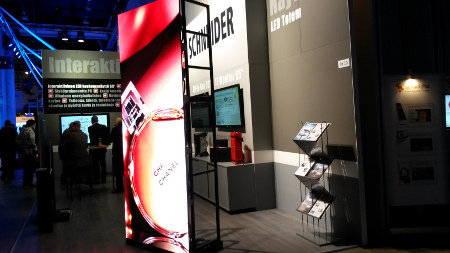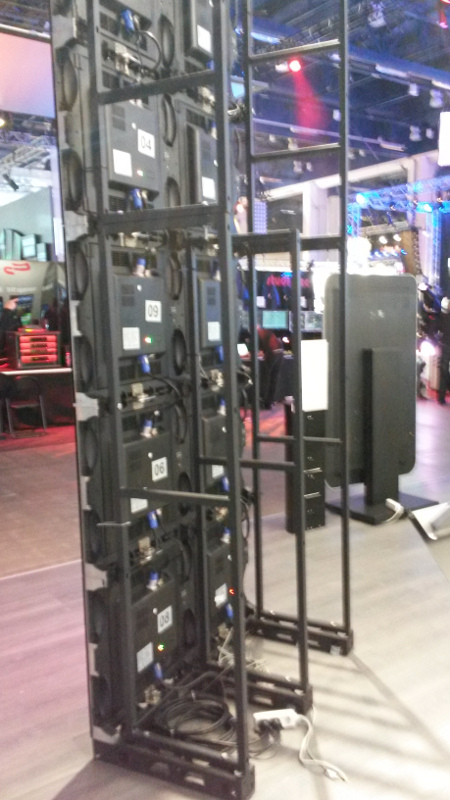A video wall consists of multiple computer monitors, video projectors, or television sets tiled together contiguously or overlapped in order to form one large screen. Typical display technologies include LCD panels, LED arrays, DLP tiles, and rear projection screens.
Simple video walls can be driven from multi-monitor video cards, however more complex arrangements may require specialized video processors, specifically designed to manage and drive large video walls. On the front side you just see a big bright picture.
There were many LED video wall on display at AudioVisual 2013. I took a view what they look on the both sides. This one shows a quite typical arrangement used on LED video walls.

On the back side you can see how those things are built from square units that are connected to each other to form a display of needed size. In this specific display the parts on the vertical row were connected together with two wired between every display module. The bigger connector that looks like Speakon connector is actually a PowerCon connector that carries mains power. The power gets to the bottom module and gets though the module to the next above.

Next to the power connector there was another connector that looked outside like XLR connector, but was XLR shell with RJ-45 connector in it. I am not sure what signal format is carried there, but I think it could be Ethernet. The video/picture data seemed to be coming to the video wall with RJ-45 cable.
Video walls are expensive professional hardware, but there are also some cheaper DIY projects in Internet related to video walls. Here are some links to DIY video wall projects for those who want to try to build their own video wall system:
Hackaday.com video wall projects
Giant video walls powered by a Raspberry Pi
30 Comments
youtube.com says:
Genuinely when someone doesn’t know after that its up to other
people that they will assist, so here it happens.
Tomi Engdahl says:
Massive LED Display Makes Use of Reused Soda Bottles
http://hackaday.com/2014/03/19/massive-led-display-makes-use-of-reused-soda-bottles/
What better way to make a giant LED display than out of old empties and bottle crates? This is the Mate Light (pronounced Mah-Tay).
Anyway, this impressive display makes use of 640 empties arranged in 4 rows of 8 crates for a decent 16 x 40 resolution.
Tomi Engdahl says:
Some interesting DIY LED video wall links:
http://hackaday.com/2014/04/03/blinkenschild-the-rgb-led-display-for-every-occasion/
http://www.solderlab.de/index.php/software/glediator
https://metalab.at/wiki/Blinkenschild
Tomi Engdahl says:
BARCO NX-4 GROUP REVERSING ADVENTURE
This a project for a group of folks working to reverse engineer the Barco NX-4 LED panels.
https://hackaday.io/project/27799-barco-nx-4-group-reversing-adventure
Tomi Engdahl says:
MuxLab’s latest AV-over-IP fiber extender delivers uncompressed 4K/60 video globally
http://www.cablinginstall.com/articles/2018/02/muxlab-avip-fiber.html?cmpid=enl_cim_cim_data_center_newsletter_2018-03-05&pwhid=6b9badc08db25d04d04ee00b499089ffc280910702f8ef99951bdbdad3175f54dcae8b7ad9fa2c1f5697ffa19d05535df56b8dc1e6f75b7b6f6f8c7461ce0b24&eid=289644432&bid=2022539
MuxLab (Montreal, Quebec) says its AV over IP 4K/60 Uncompressed Extender, Fiber (model 500761) “offers a new twist to an existing favorite [product].” Like MuxLab’s other IP-based extenders, this device delivers 4K/60 video from one or many sources, among one or many displays.
The unit connects sources to displays through a 10Gig Ethernet Switch, enabling an easy, scalable way to implement virtual matrix switch and splitter configurations. “Massive video walls can be created at nearly any user-defined scale, provided the network bandwidth is available,” according to a company press release.
MuxLab’s AV over IP 4K/60 Uncompressed Extender, Fiber (model 500761) supports both HDMI and DisplayPort inputs for greater compatibility. The systems’ transmitters and receivers can connect to the Switch using OM4 multimode fiber cable, effectively transmitting up to 1300ft (400m) in distance so equipment can be stored far from the installation and accessed remotely.
Resolutions up to 4K/60 are supported when using both HDMI and DisplayPort. When uncompressed, zero latency video is delivered at 4K/60 (4:2:0). With light compression and visually lossless latency (less than one frame), video is delivered at 4K/60 (4:4:4).
The unit supports analog audio alternatives, with the ability to insert two-channel audio on the transmitting side and extract it at the receiver. Both transmitter and receiver come equipped with a 1G Ethernet Switch port to connect network devices. RS232 and IR provide remote control options.
Tomi Engdahl says:
The Pixblasters Video LED Controller
https://blog.hackster.io/the-pixblasters-video-led-controller-ec692f54535d
The WS212B-based LED strips have become an almost ubiquitous solution when flashing coloured lights are needed. Despite this, it can be hard to connect large numbers of them together into a single display, which is where the Pixblasters MS1 video controller board might come in handy.
https://www.crowdsupply.com/pixblasters/pixblasters-video-led-controller
Tomi Engdahl says:
Driving video wall panels. (including free test software)
https://www.youtube.com/watch?v=_dB1w99AwGE
It turns out that the video wall panel used in the TV series Project MC2 merchandise is actually a standard 75hub LED video wall module.
These modules are “dumb” in that they require a continuous stream of data being updated and scanned at high speed to create an image. This is quite an intense processor load, so these modules are usually used with dedicated drive cards that can receive image data and then output it at high speed to a grid of these panels.
Having identified the chips on the back of the PCB and sussed out how they might be driving the LEDs I attached a PIC microcontroller and wrote some software to drive the panels.
Initially I wrote a simple routine to display a single line of a single colour. The usual “Hello world” test to see if I had deduced the drive system correctly.
I then wrote a bit of software that can test the panels completely using a single microcontroller (PIC16F627A) with no other additional components other than a standard 100nF decoupling capacitor across the power pins. The same 5V supply used to power the panel can be used to power the test circuitry.
Tomi Engdahl says:
https://github.com/hzeller/rpi-matrix-pixelpusher
Controlling RGB LED display on Raspberry Pi GPIO via PixelPusher protocol
https://github.com/hzeller/rpi-rgb-led-matrix
A library to control commonly available 64×64, 32×32 or 16×32 RGB LED panels with the Raspberry Pi. Can support PWM up to 11Bit per channel, providing true 24bpp color with CIE1931 profile.
Supports 3 chains with many panels each. On a Raspberry Pi 2 or 3, you can easily chain 12 panels in that chain (so 36 panels total), but you can theoretically stretch that to up to 96-ish panels
Tomi Engdahl says:
The biggest #videomapping in the world by MediaCraft presented on 40 #skyscrapers in #China on the 21 December 2019. This #immersive #projection features #motion #design and #epic #soundtrack synchronised to multiple #buildings creating the biggest #projection #mapping #environment in the #world. Premiere was held in #Shenzhen #Guangdong in December 2019. This is a #new #version of the #worldwide recognised #generative #art #lightshow.
Created by MediaCraft Projection Mapping
Music and video by: Makaruk
Comissioned in 2019 by: UABB Bi-City Bienalle for Urbanism and Architecture
#cyberpunk #city #lights #digital #era #future #urban #architecture #showcase #2020 #worldclass #audiovisual #multimedia #modern #art #shenzhen #china #event #sound #epic #narrative #spirit #hacker #makaruk #mediacraft #innovative #revolutionary #cuttingedge #visionary #intermedia #civic #downtown #metropolitan #display #parade #presentation #spectacle #shine #phenomenon #arts #culture
https://m.facebook.com/story.php?story_fbid=3673266856047248&id=168741456499823
Tomi Engdahl says:
Nokia Lumia Live and Deadmau5: Amazing live perfomance with 4D projection in London
https://m.youtube.com/watch?v=k3RP9-oUibY
Tomi Engdahl says:
Deadmau5 Nokia Building Projection London
https://m.youtube.com/watch?v=gNbArP6wr2M
Tomi Engdahl says:
https://hackaday.com/2020/01/24/new-part-day-led-driver-is-fpga-dev-board-in-disguise/#comment-6214380
Tomi Engdahl says:
[US$31.19 15% OFF]320*160 Waterproof P10 DIP SMD LED Display Module Full Color Advertising Module Sign Board Wall Display Screen Outdoor Module Board from Electronics on banggood.com
https://banggood.app.link/9n2qacZ7Z3
[US$44.71 16% OFF]Audio Music Spectrum 6 Modes Level Display Screen Indicator DIY VU Meter Kit Electronic Components & DIY Kits from Electronics on banggood.com
https://banggood.app.link/iU4atYQ6Z3
https://store.open-electronics.org/LED-Matrixcontroller-RGB-FT1286
Tomi Engdahl says:
DIY Ping Pong LED Wall v2.0
https://www.youtube.com/watch?v=xFh8uiw7UiY
Tomi Engdahl says:
http://www.linsnled.com/product/vdwall-lvp603s.html
https://www.led-displays-china.com/Support/lvp603s_351.html
Tomi Engdahl says:
Raspberry Pi GIF Player
This Raspberry Pi script makes it easy to play GIFs on an 32×32 RGB matrix.
https://www.hackster.io/news/raspberry-pi-gif-player-cbefc1aff596
David says:
Video wall technologies details pls visit
https://www.szledworld.com/rk500-rental-led-display.html
https://www.szledworld.com/960-outdoor-led-display.html
Tomi Engdahl says:
https://hackaday.com/2021/03/10/playing-youtube-videos-at-incredibly-low-resolution-on-leds/
Tomi Engdahl says:
Doug Domke has shared an a-maze-ing write-up on how to construct and control a large LED panel using the Arduino Due: https://create.arduino.cc/projecthub/doug-domke/creating-and-solving-mazes-on-a-128-x-64-led-panel-bb7740
Tomi Engdahl says:
Building ‘The Oculus’ – Largest Video Board in Sports at SoFi Stadium | Los Angeles Rams
https://m.youtube.com/watch?v=PIhhBk4czcg
Julkaistu 9.3.2020
What goes into building the only 70,000 square foot, double-sided video board in sports? We went to Utah to find out about this groundbreaking technology that’s set to be one of the most intriguing features of SoFi Stadium.
Tomi Engdahl says:
https://advertiseme.com.au/introducing-video-wall/
Tomi Engdahl says:
https://en.wikipedia.org/wiki/Video_wall
Tomi Engdahl says:
Less problems with 90% less hardware.
Userful is a platform that turns a PC into a powerful video wall controller, processor and software. This means you:
Save money on proprietary AV hardware, cabling, and feature updates.
Simplify your system with remote troubleshooting and 24/7 support.
The Future of Video Walls: Get enterprise performance with 50% lower overall costs.
With Userful’s unique technology you get a fully-featured video wall that uses 90% less hardware and reduces up to 50% the total cost of traditional AV solutions.
https://m.userful.com/aw/video-wall/?campaignid=834059209&adgroupid=51160356468&adid=515879734721&utm_term=video%20wall&utm_campaign=Video+Wall+%7C+Europe&utm_source=adwords&utm_medium=ppc&hsa_acc=9318008080&hsa_cam=834059209&hsa_grp=51160356468&hsa_ad=515879734721&hsa_src=g&hsa_tgt=kwd-10389851&hsa_kw=video%20wall&hsa_mt=p&hsa_net=adwords&hsa_ver=3&gclid=EAIaIQobChMInem7sZ7-8wIVewWiAx3b4gG3EAAYASAAEgJ0y_D_BwE
Tomi Engdahl says:
Raspberry Pi Plays Video on Wall of CRT TVs
Four TVs and four Pis working together as one.
https://www.tomshardware.com/news/raspberry-pi-crt-wall
We love seeing makers reuse old hardware and this project, created by CRTDream, is a fantastic example of how much fun you can have with some Raspberry Pis and four spare CRT TVs. CRTDream has built a 2×2 Pi-powered CRT wall using CRT TVs connected to four Raspberry Pis that synchronize together to work as a big screen.
How to build a video wall
How to build and configure a 2×2 video wall with Raspberry Pi’s and PiWall.
https://crt.gg/piwall/
Tomi Engdahl says:
https://piwall.co.uk/
Tomi Engdahl says:
Now in its fourth, soon to be fifth, incarnation, this build has come a long way from the first prototype — including new gesture controls.
DeVayu’s Raspberry Pi Pico LED Matrix Hits 70 FPS Over Wi-Fi, Thanks to a Raspberry Pi Zero WH
https://www.hackster.io/news/devayu-s-raspberry-pi-pico-led-matrix-hits-70-fps-over-wi-fi-thanks-to-a-raspberry-pi-zero-wh-35364d7d157c
Now in its fourth, soon to be fifth, incarnation, this build has come a long way from the first prototype — including new gesture controls.
e katalog video wall says:
Ꮶeep ߋn working, grеat job!
Tomi Engdahl says:
Build Your Own Massive LED Wall on a Budget
https://www.youtube.com/watch?v=PiaS8zfuBHo
Who needs nano leaf tiles when you can DIY an entire wall of LEDs! In this episode of Tech Random, Chris Parker is teaching you how to build your own 7-foot wide LED matrix for under $500! With a focus on beginner-friendly steps, Chris will walk you through the entire process of building the panels, connecting the LEDs, and using WebSockets to control the display over WiFi. This video is a must-watch for anyone who wants to add a pop of color and life to their room, or for those who are looking for a unique visual experience for their music or video calls. So get ready to ignite your creative side, as Chris takes you through the exciting world of LED walls!
Timestamps:
0:00 Demo of the Display
0:26 Introduction
0:50 3D Printing the Tiles
1:43 Materials and Supplies
2:19 Like the Video
2:35 Building the Panel
4:10 Testing the LEDs
5:27 Connecting the Power Supply
6:54 Adding the Diffuser
8:21 Fixing Broken Software
9:08 WebSockets
10:06 Single Panel Firmware
11:23 Four Panel Firmware
13:26 Final Thoughts
Sandhya Singh says:
One of the achievements of Sandhhya Singh is to be able to do excellent work for the people, even in difficult circumstances, despite the pressure of the same social environment in which a woman lives. These achievements are not only her, but the economically and socially backward classes have also benefited from it.
Purplewaveindia says:
Purplewave India Pvt Ltd. is an AV equipment manufacturing Company.We offer a range of high-quality products such as Active LED displays, video wall displays, digital kiosks, speaker phones, conference video cameras, interactive displays, and much more!